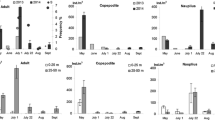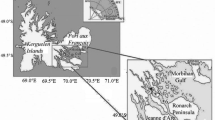Abstract.
Triacylglycerols were the major lipid and wax esters a minor lipid in the Arctic autochthonous, sympagic amphipod, Gammarus wilkitzkii, from less than 1 year old to 3 years old in the Marginal Ice Zone around Svalbard. The fatty acids of the triacylglycerols, especially in young G. wilkitzkii, were mainly characteristic of diatoms and, to a lesser extent, flagellates. Small amounts of 20:1n-9 and 22:1n-11 fatty acids characteristic of calanoid copepods were also present in the triacylglycerols in young G. wilkitzkii from the Marginal Ice Zone and the amounts of both of these fatty acids increased in the triacylglycerols as the animals matured. G. wilkitzkii in open waters in Kongsfjord had minor amounts of triacylglycerols rich in 20:1n-9 and 22:1n-11 and major amounts of wax esters characteristic of calanoid copepods. We conclude that young G. wilkitzkii in the Marginal Ice Zone feed predominantly on ice algae and that they consume increasing amounts of calanoid copepods as they mature, albeit with ice algae remaining a prominent component of their diet. In open waters, young G. wilkitzkii consume mainly calanoid copepods.
Similar content being viewed by others
Author information
Authors and Affiliations
Additional information
Electronic Publication
Rights and permissions
About this article
Cite this article
Scott, C.L., Falk-Petersen, S., Gulliksen, B. et al. Lipid indicators of the diet of the sympagic amphipod Gammarus wilkitzkii in the Marginal Ice Zone and in open waters of Svalbard (Arctic). Polar Biol 24, 572–576 (2001). https://doi.org/10.1007/s003000100252
Accepted:
Issue Date:
DOI: https://doi.org/10.1007/s003000100252




